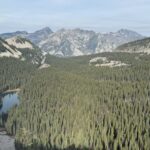 By Derf Johnson
By Derf Johnson
Readers of Down to Earth and long-time MEIC members are likely quite familiar with the proposed Montanore and Rock Creek Mines in far northwest Montana. These mines, which threaten an incredibly unique wildlife refuge, a Wilderness area, a sacred Indigenous space, and a portion of the great North American inland temperate rainforest, have been proposed in one fashion or another since the 1980s, when MEIC first publicly opposed the mines.
The proposed mines primarily target a silver deposit under the Cabinet Mountains Wilderness area (on the east and west sides of the Cabinet Mountains), and are owned by Hecla Mining Company, headquartered in Coeur d’Alene, Idaho. While the mines have been proposed for decades, recent developments could have significant bearing on their likelihood of being fully permitted.
Rock Creek Mine “Shelved”
Recently, Hecla announced a change in strategy whereby the company would focus its efforts almost exclusively on the permitting of the Montanore Mine and is withdrawing (for the time being) its permitting efforts at Rock Creek. Notably, Hecla has allowed the U.S. Forest Service-required “Plan of Operation” to expire at the Rock Creek site and the Montana Department of Environmental Quality (DEQ) has terminated the water pollution discharge permit at Hecla’s request. Through a spokesperson, Hecla has stated that it believes the permitting of the Montanore project will be an easier path forward. Regardless, this is a significant turn of events, being that this mine has been proposed for several decades and is now being placed on the back-burner.
Montanore Exploration Under Review
With its renewed focus on the proposed Montanore Mine, Hecla is now interested in again conducting major exploration work at the site. If permitted, Hecla would be allowed to conduct mining activities directly adjacent to a federally designated Wilderness area, including the buildout of additional underground access tunnels beneath Forest Service lands, expansion of its current waste rock storage area, the construction of an additional waste rock storage impoundment, and dewatering activities. The Kootenai National Forest is in the “scoping” process of an environmental review and is planning on conducting an environmental assessment on the project, which will include an opportunity for public comment and a public hearing process. Because of the major environmental implications associated with the Montanore Mine, MEIC and our partner organizations are requesting that the Forest Service conduct a full environmental impact statement. Stay tuned, because we need to be ready to push back against Hecla’s renewed interest in Montanore.
Bad Actor Case Moving Forward
The saga continues in Montana’s retreat from its enforcement obligations against Phillips S. Baker, Jr., and Hecla (for its association with Baker) due to Baker’s leadership role at Pegasus Gold when it failed to cleanup the Zortman-Landusky gold mine. On November 9, a contingent of lawyers argued the case in Helena’s courthouse, including attorneys representing the Fort Belknap Indian Community, Confederated Salish and Kootenai Tribes, and conservation organizations, as well as DEQ and Hecla mining. Earthjustice attorney Amanda Galvan spoke on behalf of the Tribes and conservation organizations, and very clearly and intelligibly explained the case and our concerns to the judge. It’s clear that, based on the law, we should win. However, now that the hearing has occurred, the case is fully in the judge’s hands to decide. There is no deadline for the judge to make a decision, but typically orders are issued within a year’s time.
This article was published in the Dec. 2022 issue of Down To Earth.


